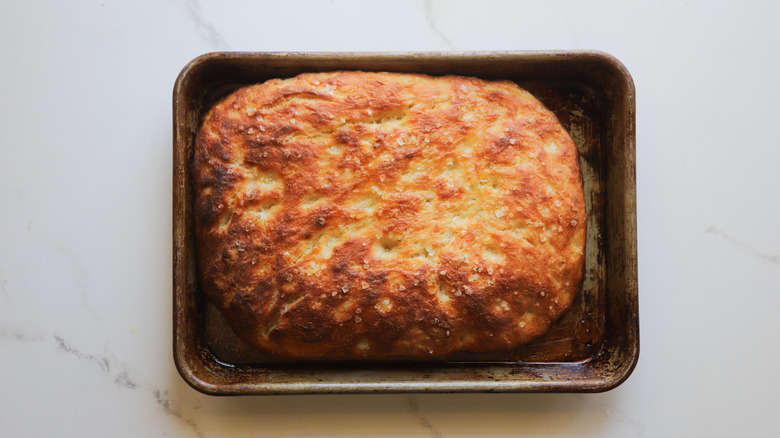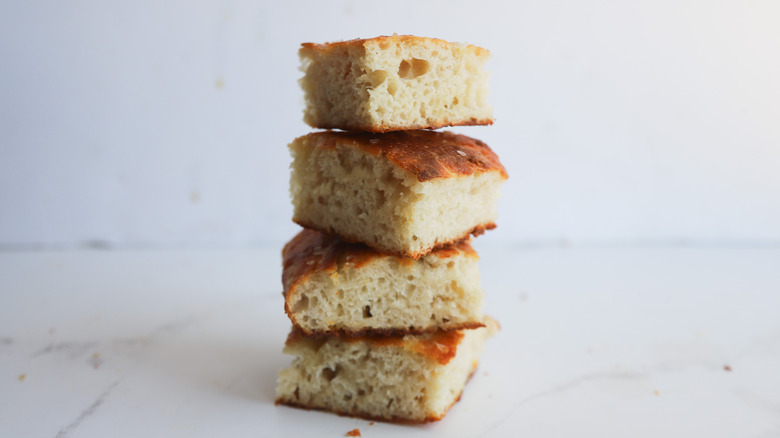Easy Homemade Focaccia Recipe
Focaccia, with its characteristic dimpled surface, is a flat oven-baked Italian bread that originated in ancient times. It is believed to predate even pizza, with both Roman and Greek civilizations leaving records of a similar type of bread. Traditionally made with flour, olive oil, water, salt, and yeast, focaccia was originally baked on the hearth of a hot fire, or on a heated tile or earthenware disk, similar to today's pizza stone. What differentiates focaccia from other breads is the olive oil-coated exterior. This is what gives it its signature crispy crust, as the bread almost fries in the oven.
This recipe from developer Taylor Murray pays homage to the timeless beauty of a classic focaccia. It is one of the easiest breads to make, though there are a few common pitfalls to keep in mind. If you've always wanted to try your hand at bread baking, start with this one.
Gather the focaccia ingredients
Focaccia is one of the easiest breads to make at home. The only ingredients you need are basic all-purpose flour, active dry yeast, salt, and olive oil. There are recipes for focaccia that use instant yeast or even sourdough starter, but active dry yeast is simple, cheap, and easy to work with, so we used that for this version. You can find this in the baking aisle of any supermarket.
You'll also use some plain, tepid water to make the dough, and if you want, some flaky sea salt to finish.
Mix the dough
Coat a large bowl with olive oil. In another large bowl, whisk together the flour, kosher salt, and yeast. Pour the water into the dry mixture and stir until just incorporated. You can use a wooden spoon, your hand, or a mixer fitted with the dough hook attachment. Make sure the water is tepid, or about 100 F. This is an extremely important aspect of baking with yeast. The water has to be warm enough for the yeast to activate, without being so hot that it kills the yeast completely.
Let it rest
Transfer the dough to the oiled bowl, cover, and refrigerate for 12 to 48 hours. This allows the yeast to activate and aerate the dough. "I've made this recipe a hundred times and baked it at any point between 12 and 48 hours with no issues. One of the great things about baking focaccia is it is one of the most forgiving breads," says Murray.
Prepare the oven and tray
When ready to bake, preheat the oven to 425 F. This temperature is important as too hot could risk burning your bread before it is fully cooked on the inside, and too low would not produce the desired results for the crust.
Prepare a sheet tray by coating it with half the remaining olive oil. In order for focaccia to have its signature crust, the oven has to be hot enough for the oil to oven fry the exterior. This is why we coat the dough in oil before baking.
Let it rise (again)
Turn the dough out onto the oiled sheet tray. Stretch and press the dough towards the edges and corners evenly. Place in a warm area and let rise for 1-2 hours, or until the dough looks airy and has risen. Dimple the dough all over with your fingers. These characteristic dimples are essential to focaccia making as each divot holds a little pool of olive oil. As the bread bakes, the oil heats enough to lightly fry the bread from the outside.
Drizzle with remaining olive oil and sprinkle with flaky sea salt. If you'd like to add other toppings to your focaccia, such as tomatoes, peaches, or herbs, you would add them after the olive oil, but before the salt. "The flaky sea salt isn't strictly necessary to making focaccia, but it gives a nice crispy, salty texture to the outside," says Murray.
Bake the bread
Transfer the dough and tray to the oven and bake for 15 to 20 minutes, turning once, until golden brown all over. The crust should be hard and crusty, with a slight amount of bounce in the center.
Cool it
Remove the focaccia from the tray (once it's cool enough to handle!) with a metal spatula and let cool completely before slicing with a bread knife and enjoying.
If keeping overnight, wrap tightly in plastic and store at room temperature for up to three days. You can re-crisp it in the oven by briefly toasting it, or cutting it in half horizontally and toasting it in a pan.
Serving focaccia
Of course, there's nothing wrong with enjoying focaccia on its own, or dipped in a bit of olive oil and vinegar, but there are so many uses that go beyond that. Its hearty texture and flavorful crust make it an excellent choice as a sandwich bread, where it can be sliced horizontally and filled with ingredients like mozzarella, tomato, and basil, or prosciutto and provolone. You can also treat focaccia like a pizza crust. Prior to baking, simply top it with your favorite pizza ingredients such as mozzarella, tomatoes, and olives.
Focaccia can also be cubed and used in bread salads like an Italian panzanella, where it readily soaks up the dressing and the flavors of the other salad ingredients. Lastly, don't forget that a slice of focaccia can also be a delightful start to your day, especially when topped with breakfast favorites like a fried egg, bacon, or avocado.

- 1/4 cup olive oil
- 3 1/2 cups all purpose flour
- 1 tablespoons kosher salt
- 1/2 teaspoon dry active yeast
- 1 3/4 cups tepid water
- 2 teaspoons flaky sea salt
- Rub oil in a large bowl and set aside.
- Whisk together flour, kosher salt, and yeast.
- Pour water into dry mixture and stir until just incorporated.
- Transfer the dough to the oiled bowl, cover, and refrigerate for 12 to 48 hours.
- Preheat the oven to 425 F. Prepare a sheet tray by coating with half of the remaining olive oil.
- Turn the dough out onto the oiled sheet tray. Stretch and press the dough towards the edges and corners evenly.
- Place the tray in a warm area and let rise for about 1-2 hours, or until dough looks airy and risen.
- Dimple the dough all over with your fingers. Drizzle lightly with olive oil and sprinkle with flaky sea salt.
- Bake for 15 to 20 minutes, turning once halfway.
- When cool enough to handle, remove from the sheet tray with a large metal spatula. Allow to cool an additional 15 minutes before slicing.
| Calories per Serving | 173 |
| Total Fat | 4.9 g |
| Saturated Fat | 0.7 g |
| Trans Fat | 0.0 g |
| Cholesterol | 0.0 mg |
| Total Carbohydrates | 27.9 g |
| Dietary Fiber | 1.0 g |
| Total Sugars | 0.1 g |
| Sodium | 175.9 mg |
| Protein | 3.8 g |









